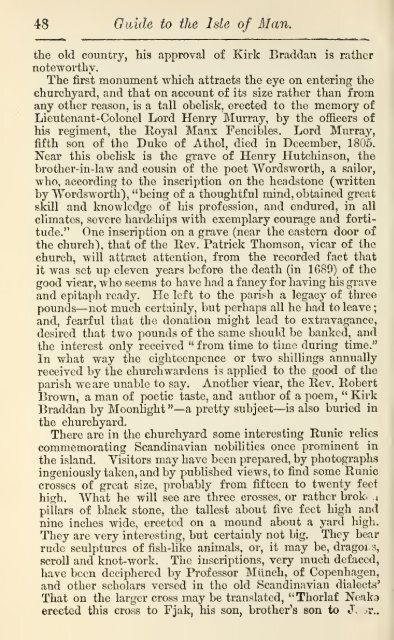Ward & Lock's descriptive and pictorial guide to the Isle of Man ...
Ward & Lock's descriptive and pictorial guide to the Isle of Man ...
Ward & Lock's descriptive and pictorial guide to the Isle of Man ...
Create successful ePaper yourself
Turn your PDF publications into a flip-book with our unique Google optimized e-Paper software.
;48 Guide <strong>to</strong> <strong>the</strong> <strong>Isle</strong> <strong>of</strong> <strong>Man</strong>.<strong>the</strong> old country, his approval <strong>of</strong> Kirk Braddan is ra<strong>the</strong>rnoteworthy.The first monument which attracts <strong>the</strong> eye on entering <strong>the</strong>churchyard, <strong>and</strong> that on account <strong>of</strong> its size ra<strong>the</strong>r than fromany o<strong>the</strong>r reason, is a tall obelisk, erected <strong>to</strong> <strong>the</strong> memory <strong>of</strong>Lieutenant-Colonel Lord Henry Murray, by <strong>the</strong> <strong>of</strong>ficers <strong>of</strong>his regiment, <strong>the</strong> Royal <strong>Man</strong>x Fenciblcs. Lord Murray,fifth son <strong>of</strong> <strong>the</strong> Duke <strong>of</strong> Athol, died in December, 1805.Near this obehsk is <strong>the</strong> grave <strong>of</strong> Henry Hutchinson, <strong>the</strong>bro<strong>the</strong>r-in-law <strong>and</strong> cousin <strong>of</strong> <strong>the</strong> poet Wordsworth, a sailor,who, according <strong>to</strong> <strong>the</strong> inscription on <strong>the</strong> heads<strong>to</strong>ne (writtenby Wordsworth), "being <strong>of</strong> a thoughtful mind, obtained greatskill <strong>and</strong> knowledge <strong>of</strong> his pr<strong>of</strong>ession, <strong>and</strong> endured, in allclimates, severe hardships with exemplary courage <strong>and</strong> fortitude."One inscription on a grave (near <strong>the</strong> eastern door <strong>of</strong><strong>the</strong> church), that <strong>of</strong> <strong>the</strong> Eev. Patrick Thomson, vicar <strong>of</strong> <strong>the</strong>church, will attract attention, from <strong>the</strong> recorded fact thatit was set up eleven years before <strong>the</strong> death (in 1680) <strong>of</strong> <strong>the</strong>good vicar, who seems <strong>to</strong> have had a fancy for having his grave<strong>and</strong> epitaph ready. He left <strong>to</strong> <strong>the</strong> parish a legacy <strong>of</strong> threepounds— not much certainly, but perhaps all he had <strong>to</strong> leave<strong>and</strong>, fearful that <strong>the</strong> donation might lead <strong>to</strong> extravagance,desired that two pounds <strong>of</strong> <strong>the</strong> same should be banked, <strong>and</strong><strong>the</strong> interest only received " from time <strong>to</strong> time during time."In what way <strong>the</strong> eighteenpence or two shillings annuallyreceived by <strong>the</strong> churchwardens is applied <strong>to</strong> <strong>the</strong> good <strong>of</strong> <strong>the</strong>parish we are unable <strong>to</strong> say. Ano<strong>the</strong>r vicar, <strong>the</strong> Rev. RobertBrown, a man <strong>of</strong> poetic taste, <strong>and</strong> author <strong>of</strong> a poem, "KirkBraddan by Moonlight"—a pretty subject—is also buried in<strong>the</strong> churchyard.There are in <strong>the</strong> churchyard some interesting Runic relicscommemorating Sc<strong>and</strong>inavian nobilities once prominent in<strong>the</strong> isl<strong>and</strong>. Visi<strong>to</strong>rs may have been prepared, by pho<strong>to</strong>graphsingeniously taken, <strong>and</strong> by published views, <strong>to</strong> find some Runiccrosses <strong>of</strong> great size, probably from fifteen <strong>to</strong> twenty feethigh. What he will see are three crosses, or ra<strong>the</strong>r brok »pillars <strong>of</strong> black s<strong>to</strong>ne, <strong>the</strong> tallest about five feet high <strong>and</strong>nine inches wide, erected on a mound about a yard high.They are very interesting, but certainly not big. They bearrude sculptures <strong>of</strong> fish-like animals, or, it may be, dragoi s,scroll <strong>and</strong> knot-work. The inscriptions, very much defaced,have been deciphered by Pr<strong>of</strong>essor Munch, <strong>of</strong> Copenhagen,<strong>and</strong> o<strong>the</strong>r scholars versed in <strong>the</strong> old Sc<strong>and</strong>inavian dialects'That on <strong>the</strong> larger cross may be translated, "Thorlaf Neakaerected this cross <strong>to</strong> Fjak, his son, bro<strong>the</strong>r's son <strong>to</strong> J r..
















